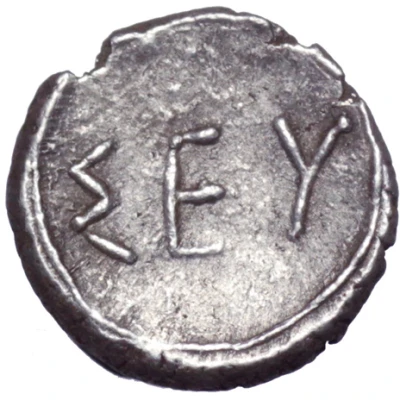


© Roma Numismatics Limited
Trihemiobol - Seuthes I 424 BC - 405 BC
| Silver | 0.84 g | 10 mm |
| Issuer | Kingdom of Odryssa (Thracians) |
|---|---|
| King | Seuthes I (424 BC - 407 BC) |
| Type | Standard circulation coin |
| Years | 424 BC - 405 BC |
| Value | Trihemiobol (¼) |
| Currency | Drachm |
| Composition | Silver |
| Weight | 0.84 g |
| Diameter | 10 mm |
| Shape | Round (irregular) |
| Technique | Hammered |
| Demonetized | Yes |
| Updated | 2024-10-09 |
| Numista | N#234191 |
|---|---|
| Rarity index | 100% |
Reverse
Script: Greek
Lettering: ΣEV
Comment
Seuthes I (424-405 BC) or Seuthes II (405-386 BC)Peter p.77 = Topalov p.172.
Only two known examples. Only around six pieces in the name of Seuthes I / II known to exist.
The silver coinage in the name of Seuthes has been most frequently attributed to Seuthes I, though given the paucity of information and find evidence a definitive attribution to this king remains elusive. Stylistic and metrological analysis suggest a date of issue in the period of the mid-5th to mid-4th century BC (see Peter, p. 78), though this could equally well apply to either Seuthes I or II.
The former is ingloriously remembered for ending the campaign of his uncle King Sitalkes in Macedon, after allowing himself to be bribed by the Macedonian king Perdikkas II. Thucydides speculated that Seuthes had a hand in the death of his uncle, to whose throne he succeeded in 424 BC. Yet, under his rule, the Odrysian kingdom grew to new heights of power and wealth. Upon his death he was succeeded by Amadokos I, who made Seuthes II ruler of the kingdom's Aegean shore territories. (Source: Roma Numismatics Auction 6 Catalog, 29 September 2013)
Interesting fact
The Trihemiobol coin featuring Seuthes I, king of the Odryssa kingdom (a Thracian tribe) has a unique feature - it has a square shape! Most coins of that era were round in shape, but this particular coin was minted with a square shape, which makes it stand out among other ancient coins.



